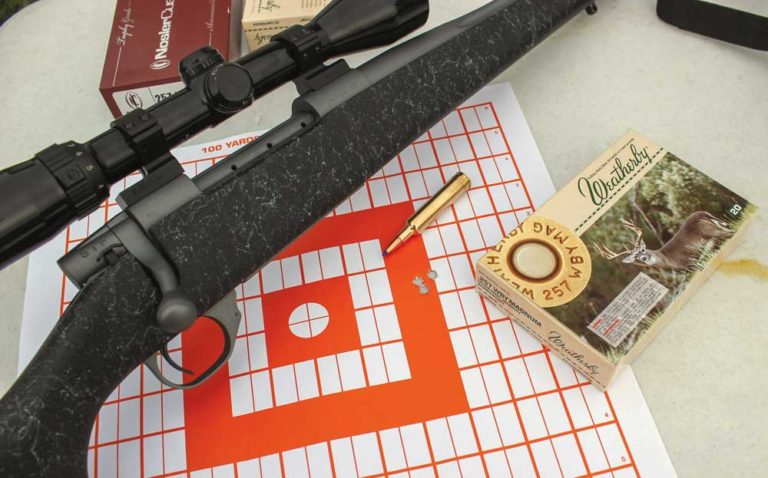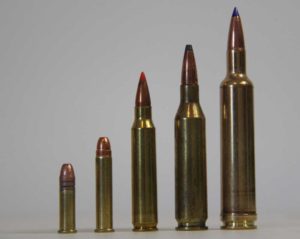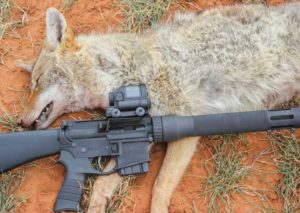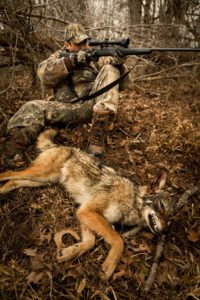
 An Offer I Couldn't Refuse
An Offer I Couldn't Refuse
On a whitetail hunt at the JL Bar Ranch in Texas two years ago, I tagged out early and my guide asked if I was interested in spending the remaining mornings and evenings calling gray fox on the far side of the ranch. The cover was thick over there, he said, and since there were no deer hunters on that side of the property we wouldn’t blow anyone’s chances at a big buck. I should have been working—I had a deadline looming, I clearly remember—but I simply couldn’t pass on an opportunity to hunt predators in a new part of the country.
I was glad that I took him up on the offer. We hadn’t been set up for more than two minutes when the first gray appeared, almost literally, in our lap. That fox came so quickly and was so close that no one had a chance to shoot, but within 30 seconds another fox approached us at a trot from the opposite side. This time we were ready, and when the gray stopped at 40 yards and the .17 HMR barked, he went down hard, the first of several we took over the next few days.
Considering All the Options
A really outstanding predator hunt like the one I had at the JL Bar can be as exciting as just about any type of hunting. But despite the affordability and availability of predator hunting, there are certainly some important decisions that need to be made with regard to caliber. You need a gun that matches the style of hunting and the country, so a big, heavy-barreled rifle chambered in one of the hot .22s, which is a great choice for calling coyotes from a hilltop setup in Wyoming, isn’t the best option for a hunt that will require a lot of walking and quick, close shooting like our fox hunt in Texas. Conversely, the .17s that served so well in Texas won’t be very effective for those long-range setups in windy country where your closest shot might be a couple hundred yards.
The 10 Best Predator Calibers of All Time

There’s a lot of diversity, then, on our 10-best list. These cartridges may not suit all hunters, but no matter what type of predator you are hunting, from weasels to wolves, there’s a round on this list that deserves top billing.
.17 HMR
The .17 Remington was a fine moderate-range varmint and predator cartridge, but it never really was a commercial success. The .17 HMR, which was released by Hornady in 2002, however, was exactly what the .17 shooters were looking for. It could reach high (2,500 fps-plus) velocities and shot flat, but that little bullet didn’t destroy pelts, and it was an effective killer. There are lots of good, cheap loads, and Savage is now offering its affordable and deadly accurate A17 semi-auto rifle in this caliber. Recoil is barely noticeable, muzzle blast isn’t awful, and when ranges are moderate, this is an outstanding option for smaller predators. It’s also a great option for new hunters.
Read More: Evolution of the Red Hot .17 HMR
.17 WSM
The .17 Winchester Super Magnum (WSM) is based, of all things, on a modified .26-caliber nail gun cartridge. But the parent cartridge’s thicker case walls allowed for higher pressures, so the .17 WSM can drive a 20-grain bullet at more than 3,000 feet per second. It pushes the .17 to new levels, but pelt damage is minimal and recoil is nil. At close to moderate ranges, it kills coyotes dead, and rifles from Savage and Ruger are affordable, available, and accurate. And while it hasn’t achieved the level of popularity of some of the other cartridges here, it has a loyal following, and those who use this cartridge are generally very satisfied with its performance.
See Also: .17 WSM vs. .17 HMR – Cartridge Debate
.204 Ruger
The .204 Ruger is based on the .222 Remington Magnum, and it is capable of firing a 32-grain bullet at better than 4,000 feet per second, so it is a legitimate long-range predator cartridge that can topple even the largest coyotes at a quarter mile. Available bullets range in weight from 24 to 55 grains, but the most common options are between 32 and 40 grains. The .204 doesn’t produce the recoil of the hotter .22s, and it has proven to be extremely accurate. For that reason, it is certainly one of the very best all-around cartridges on this list for the predator hunter who plans to pursue small game like raccoons and gray fox yet wants a rifle that will work to longer ranges on ‘yotes. Best of all, ammo is cheap and rifles are widely available.
Read More: The Ground-Breaking .204 Ruger

.22 Long Rifle
Although its applications are limited, the .22 Long Rifle is not a cartridge that should be overlooked by predator hunters who pursue small game at close range. For starters, .22 ammo is now once again widely available and cheap, and hundreds of rifles are available starting at rock-bottom prices. Is it the most versatile option here? Not by a long shot, but if you hunt smaller predators like raccoons over bait or by calling or simply want a gun that can keep small vermin under control, then the .22 is still a fine option. Not all .22 ammo is created equal, but there are some real standouts for those who prefer this caliber, cartridges like CCI’s Stinger, which pushes a 40-grain HP at 1,640 feet per second. If you sell your hides, there is no better option to preserve pelts and maximize profits.
Read More: Know your Cartridge: .22 LR
.22 WMR
The .22 WMR is a ‘tweener cartridge, a rimfire that pushes heavier (28- to 50-grain) bullets than most other loads in this class at around 2,200 feet per second. It shoots flatter than the .22 Long Rifle, has plenty of coyote-stopping power at moderate ranges, and doesn’t kick or bark like hotter loads. It pushes the limits of what a rimfire can accomplish in terms of predator rounds, but with ammo available as cheap as a quarter a shot, it’s affordable to shoot and there are a lot of great lightweight, accurate rifles available. With 40-grain hollow points, it drops game, and pelt damage is very minimal. If there’s one knock against this cartridge, it is that its popularity sometimes makes it hard to find factory ammo on store shelves.
Read More: The Best Rimfire Cartridges Ever Made
.220 Swift
The .220 Swift was one of the original hot .22 centerfires, having debuted in 1935 in the Winchester Model 54 rifle. It was based on the old 6mm Lee Navy cartridge, and original loadings pushed 40-grain bullets well past 4,000 feet per second. Like many other cartridges, the .220 Swift was ahead of its time; those blistering-fast early loads gave this cartridge the reputation as a barrel-burner, which was accurate, but modern metallurgy techniques and slightly reduced loads mean that case and barrel life with this cartridge is now on-par with other hot .22s. If you want to maximize the range of your .22-caliber rifle, this is an ideal round, perfect for dropping coyotes that hang up at a quarter mile or more. The two primary knocks are availability of rifles and ammo, and the need to be careful with shot placement and bullet selection if you want clean pelts, but the Swift is certainly an outstanding predator round.

.223 Remington/5.56 NATO
I’m lumping these two together because many hunters today use 5.56 ARs and feed them .223 Rem. ammo. No matter the platform, the .223/5.56 is probably the ultimate predator round in terms of versatility. There are tons of ammo offerings in a variety of bullet weights and plenty of choices when it comes to rifles. The .223 will do almost anything the hotter .22s will, and recoil is scant. I have used a Mossberg MMR rifle with 55-grain bullets on coyotes for several years now and that gun is deadly accurate, light enough for all-day carry and offers me the fastest follow-up possible. In truth, if I do my part, there’s no need for a follow-up, though, and there are so many bullet options available that you can achieve exactly the kind of performance you are looking for. The .223 has become to predator hunting what the .30-06 is to big game hunting. There are a lot of other choices, but there’s a reason this do-all round is on top of the pile in terms of popularity.
Read More: .223 vs 5.56 – Our Ultimate Comparison & Review
.22-250 Remington
Based on a necked-down .250-3000 Savage, the .22-250 started life as a wildcat cartridge in the 1930s and was later adopted by Remington, which gave the cartridge both its name and the clout it needed to win over the masses. This round remains one of the most popular predator cartridges, and with good reason; bullets are widely available, it’s easy to reload, shoots flat, and it’s very, very accurate. Plus, this is a cartridge that serves dutifully in a variety of bolt-action rifle designs. It’s the perfect complement for a heavy-barreled, long-range rifle with a high-magnification scope, but it also works in lighter sporters that are great for multiple setups where you need to cover a lot of ground. It beats the .223 in terms of trajectory and velocity, and it is one of the absolute best do-all predator rounds for foxes, coyotes, and bobcats out to extended ranges. Recoil isn’t as mild as it is in some of the other .22s or .17s but is still quite manageable and a fair tradeoff given this level of performance.
.243 Winchester
The .243 Winchester has been around since 1955, and it debuted the same year as Remington’s .244. The .244 Remington (now 6mm Remington) was ballistically superior, but Winchester offered a 1:10 twist rate that allowed the gun to shoot heavier 100-grain bullets accurately, making the .243 more versatile. That versatility has made this cartridge what it is today—the perfect crossover cartridge for those who want to hunt coyotes and foxes one day and deer and antelope the next. It’s based on the .308 Winchester necked down, and it will drive a 70-grain bullet faster than 3,500 feet per second. There are a bunch of affordable ammo options and lots and lots of rifles in almost every configuration imaginable, and with lighter bullets at moderate velocities, it isn’t absolute overkill on smaller predators at long ranges.
Read More: Know Your Cartridge: .243 Winchester

.257 Weatherby Magnum
I may have lost some of you with this one, I know. The .257 Weatherby Magnum is far and away more potent a round than is needed for a 200-yard shot on a coyote (Roy Weatherby actually killed a cape buffalo with this round just to prove that it could be done), but with a muzzle velocity near 3,900 feet per second with an 80-grain pill, this cartridge shoots very flat and hits very, very hard. Very few people that would choose this as their go-to coyote gun, but it works, though pelt damage will be more pronounced than with other cartridges listed here. The .257’s greatest virtue, however, is its outstanding versatility, for it will kill deer, antelope, sheep and even elk at long ranges, and it will also topple a coyote crossing an open pasture at a quarter mile. With an 80-grain Barnes TTSX bullet in Weatherby’s factory load you can sight your rifle in just under 2 inches high at 100 yards to hit dead-on at 300. At 400 yards, that bullet will be just 6.4 inches low, taking much of the guesswork out of long-range shooting. Weatherby’s Vanguard rifles are chambered in this round, and they are both accurate and affordable, and ammo isn’t nearly as expensive for this load as for some of Weatherby’s other offerings. Additionally, now that wolf hunting is legal in the Lower 48, there’s a whole new class of canine predator, and the Weatherby is up to the challenge.
Read More: Cartridge Review: The Hard-Hitting .257 Weatherby Magnum
Editor's Note: This article is from the February 2017 issue of Gun Digest the Magazine.

Next Step: Get your FREE Printable Target Pack
Enhance your shooting precision with our 62 MOA Targets, perfect for rifles and handguns. Crafted in collaboration with Storm Tactical for accuracy and versatility.
Subscribe to the Gun Digest email newsletter and get your downloadable target pack sent straight to your inbox. Stay updated with the latest firearms info in the industry.

![Best Concealed Carry Guns In 2025 [Field Tested] Wilson Combat EDC X9S 1](https://gundigest.com/wp-content/uploads/Wilson-Combat-EDC-X9S-1-324x160.jpg)


![Best 9mm Carbine: Affordable PCCs [Tested] Ruger Carbine Shooting](https://gundigest.com/wp-content/uploads/Ruger-Carbine-Shooting-100x70.jpg)
![Best AR-15: Top Options Available Today [Field Tested] Harrington and Richardson PSA XM177E2 feature](https://gundigest.com/wp-content/uploads/Harrington-and-Richardson-PSA-XM177E2-feature-100x70.jpg)

Like the to ten list. However I would have included the 5mm rem.mag rimfire. Lot of them still out there and when aguilla started producing amunition for it again a Lot of people stocked up. I like it better than 22 wmr or it. Excellent varmint roung short and mid range, under 200 yards. Also I beleave the 22 nosler is about to take center stage very soon.
Like the to ten list. However I would have included the 5mm rem.mag rimfire. Lot of them still out there and when aguilla started producing amunition for it again a Lot of people stocked up. I like it better than 22 wmr or it. Excellent varmint roung short and mid range, under 200 yards. Also I beleave the 22 nosler 22 is about to take center stage very soon.
CCI’s Stinger doesn’t use a 40 grain bullet; it’s only 32 grains. Their fastest 40 grain round is the Velocitor at 1435 fps, and it uses the same type of HP. The Velocitor is actually the superior round; the only place the Stinger delivers more energy is at the muzzle… from 25 yards on the Velocitor delivers more.
Product Information
Part # Caliber Bullet Weight(gr) Bullet Sub Brand Box Count
0050 22 Long Rifle 32 CPHP Stinger 50
0047 22 Long Rifle 40 CPHP Velocitor 50
ENERGY, ft-lbs
Load No. Caliber Muzzle 25 50 75 100
0050 22 Long Rifle 191 150 119 96 81
0047 22 Long Rifle 183 156 134 117 104
Why no mention of the 17 Hornet?